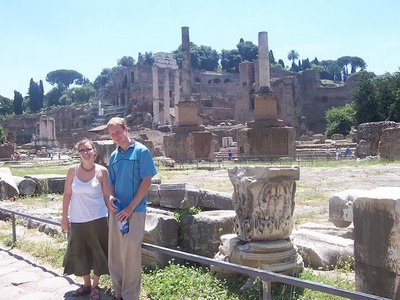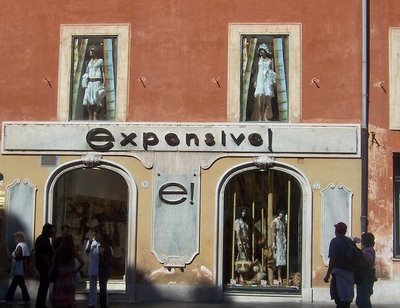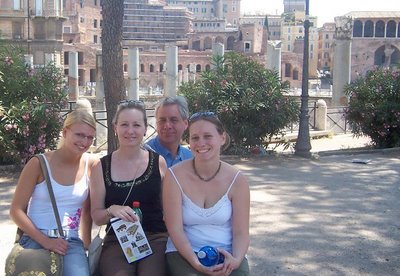Well, Italy was great and it was nice to see my family. If I’ve gained nothing else I’ve at least come to realize how important my family and long-term friends are. I’m half a world away from anyone who has known me for more than a short time, and seeing people from the States who are able to relate to me from life before in Kenya was a nice change.
I knew beforehand that going to Italy would be a culture shock. The tremendous wealth in Italy and Vatican city was such a contrast to the tin roofed shacks and run down Chinese bicycles in my village. Hot running water (that you can drink straight from the tap!), reliable electricity, and paved roads are just a few of the things I’ve learned to do without. White people everywhere; that was a bit strange too. I’ve been around Kenyans so long now that sometimes I’m almost surprised to look down at my arms and see pasty white skin. I also anticipated a culture shock coming back to Kenya, but the strange thing was it almost felt like life was back to normal once I got off the plane and onto the streets of Nairobi. After eight months this place feels like home to me, and I have so many projects to get back to that by the end of the trip I was actually looking forward to returning.
I started the trip with an Ethiopian Airlines flight though Addis Ababa (the capital city of Ethiopia) to Rome. The brief amount of Ethiopia I was able to see from the sky was enough to make me want to visit. The landscape is completely different than what I have seen in Kenya...very dry and mountainous, and the people are beautiful.
After arriving in Rome and I immediately made a beeline for McDonald’s. I ate an Egg McMuffin for breakfast and it was heavenly. During my trip I also had a BigMac and a Fillet-O-Fish supersized extra value meal. I rarely eat fast food in the States but after months of organic, natural, and flavorless Kenyan food there was something extremely comforting about greasy processed American fast food.
After finding my way through the largest train station I’ve ever been in, I caught a train towards Montepulciano. I met with my parents and sister at the station and drove in a rental car into the hilltop village. The Tuscany region is covered by small towns. They are perched atop rolling hills and surrounded by stone walls. The towns are old, and most date back to Roman times with medieval architecture built over the ancient Roman ruins. We had a chance to go to several of these towns, and before our time in Tuscany came to an end they all started to look the same: impossibly narrow roads winding though rows of ancient stone buildings, gigantic medieval churches, usually the burial place of a Saint and filled with priceless artwork and sculptures, and thousands upon thousands of tourists. It is always easy to spot Americans in the crowd; just listen for the people making the most noise. Another giveaway: North Americans are the only people who will wear white socks with their tennis shoes. Europeans wear colored socks, usually black. Try it the next time you travel abroad and I guarantee it’s a giveaway 99.5% of the time.
Of course with tourists come the people who make their living on tourist dollars. Souvenir shops and street side vendors are everywhere. There’s so many it’s a wonder they can all stay in business. The majority of souvenirs are ridiculously tacky: who, after visiting the tomb of St. Francis, doesn’t want a Pope hat or a St. Francis shot glass? Perhaps the worst of them are the souvenir shops that are actually inside the churches themselves. Doesn’t even Jesus speak out against this?
I apologize if I’m sounding skeptical. Italy really was fantastic. I’ll move on now to the best part of Tuscany, the wine. All of these small towns have wineries, where free samples are readily available. I had a good time going from shop to shop with my father, tasting various samples, and moving on to the next. By the end of the day all the wine started to taste the same and it became difficult to walk in a straight line, but it really was a lot of fun. I couldn’t understand why people were swishing the wine around in their mouth and then spitting it out, it seemed like such a waste.
There’s also a type of liquor called Grappa. It’s made by taking the leftovers after the wine is made; the vines, leaves, and pulp, and distilling it. It’s about as strong as whiskey and tastes like rubbing alcohol with a slight grapey aftertaste. Samples are readily available at most of the small wineries and it doesn’t take long to decide that one’s Grappa tolerance has been exceeded. The funny thing about it is that Grappa is available for different prices and qualities, much like the wine. All Grappa tastes the same, so I don’t really understand the point. I did try one type of Grappa, Grappa with Herbs, which tasted different, but not in a good way. It was the most vile thing I’ve ever tried and it is obviously intended for use as a gag drink and not something people would seriously enjoy. After trying a small sample I enjoyed a Grappa with Herbs aftertaste for the rest of the day.
The food was in Italy is fantastic. Typical noodle-based Italian food from the states (Lasagna, Spaghetti, etc.) is generally just a first course in Italy, followed by a second course, which is generally a meat dish. My personal favorite was the wild boar but all the food was great. It had also been quite awhile since I’d had cheese and I definitely had more than enough in Italy to last me awhile.
After a relaxing time in Tuscany we drove to Rome, where I met up with Jana, a German friend of mine living in Southern France. She had never been to Rome before and accompanied me and my family to Rome’s fantastic sites. The city is incredible and I was amazed by the elaborate fountains, ancient pillars which were once topped with Roman emperors, but are now topped with statues of St. Peter, Roman buildings dating back to before the time of Christ, and beautiful, yet overwhelmingly detailed and decorated churches. One of my favorite sites was the Coliseum. I had a chance to go inside, listen to a guide describe the gruesome gladiator battles that took place here, and see a museum full of priceless Roman antiquities. The culture of the Romans was incredibly developed. I find it strange that, with as much as the Greeks and Romans were able to accomplish, about 1200 years followed where progress and enlightenment practically came to a halt. Why, after the fall of the Roman Empire, did people not adopt the knowledge of Roman times and continue progressing? I’m sure there’s an explanation and that’s something I want to look into.
Another site definitely worth visiting is the Pantheon. It’s a huge stone building located right in the center of Rome. It is topped by what was the largest dome in the world until the 1960’s. In the Pantheon a group of monks were singing, and the acoustics in the building are just incredible. It dates to before the time of Christ, yet is perfectly preserved thanks mostly to the fact that, although it was originally built as a temple for Roman Gods, it was converted to a Catholic Church and thus preserved through the centuries. The same good fate cannot be said of the majority of ancient Rome, which lies in ruins but is still fascinating to walk though.
We also went to Vatican City. The line into the Vatican museum, which is where the Sistine Chapel is located, was three hours long, and my parents decided to skip it since they have been there before. Instead we walked on to St. Peters Basilica. St Peters is the largest church I have ever seen. It is in a stone courtyard surrounded by pillars with room for 400,000 people, and the church itself is so gigantic that it is difficult to find a sense of scale. Only when I walked directly up to one of the carved marble angels on a small section of the wall and saw that it actually much larger than I am did I start to grasp the enormity of the building. It is longer than two football fields and the roof must be at least 100 feet overhead. Every space on the wall and ceiling is covered with paintings, carvings, and sculptures from the master artists of the Renaissance. I wish I could say it felt like a spiritual experience to be there, and perhaps it was to an extent, but the church was filled with tens of thousands of camera-wielding tourists and the elaborate building was really just too much to take in for me to feel especially close to God.
One other place worth noting in Rome is a crypt where thousands of monks had their bones changed into artwork in medieval times. Bones from deceased monks have been arranged into designs, patters, and pictures. At the end of the tour is a plaque stating “What you are, we once were. What we are you will become.” The intention is to exhibit human mortality, and I found it very strange and unsettling.
After a few days in Rome my family had to catch a return flight to the states. It was great to see them, and reassuring to know I’ll be catching up with them, as well as friends from home, again over Christmas. Once they left I stayed in Italy for another two days to meet some of the people working in at the FAO headquarters in Rome. My meeting was scheduled in the afternoon before my flight left, but I had sent a confirmation email and never got a response. I then called the person I was supposed to be meeting and he told me he would be in touch sometime later in the day to finalize our meeting. More on that in a moment.
Once my parents and sister left for the States I had a free day before meeting with the FAO the following day. With help from Jana, who works as a travel agent, we were able to book a ticket to Pompeii and spend the day there. Pompeii is an ancient Roman city of 20,000 people that was destroyed by a volcano in the 1st century A.D. The remarkable thing about the city is that it was covered in volcanic ash and left perfectly preserved until it was rediscovered in the mid 1800’s. Since then the city has been excavated and now sits, uncovered, as the best preserved ancient city in the world. We took a tour of the city and walked down the cobblestone streets through what was a very developed town. Pompeii had running water, beautiful homes with tiled floors, painted walls, and swimming pools that are still intact, fast food restaurants, a supermarket, public baths, two theaters, a gymnasium, and a coliseum. There was also a Red Light district with stone penises carved into the walls throughout town pointing the way. This was apparently done because of the language barrier of sailors coming to Pompeii’s shipping port.
Of course, the strangest thing about Pompeii is what became of the many people who were in the town when Mt. Vesuvius exploded. As the volcanic ash covered the town it also covered its people, who were then perfectly preserved under a blanket of ash for 1800 years. When they were found, only skeletons remained in the ash. Plaster was used to fill the places where the people had died, and the result is a perfect impression of what the person looked like in their last moments. Facial expressions, the texture of the clothing, and even the hair style are all perfectly visible in the plaster casts. It was creepy and also sad to see the looks of people crouched to cover themselves from the ash with a terrified look on their faces.
The next day was when I needed to meet with people from the FAO, but I had never heard back and was unsure of what to do. I decided to go to the FAO headquarters office and test my luck, but when I arrived the guy I was supposed to meet was not in, and security would not let me enter the building without an escort. I was pretty disappointed, but decided to make the most of it and visit the Vatican Museum since I had missed it with my parents. I arrived late in the afternoon and the three hour line I had seen when we walked by in the morning was gone. I was able to go straight into the museum and was surrounded by priceless sculptures, paintings, tapestries, and artifacts. I had anticipated only Christian relics and artwork but there were also ancient Egyptian, Roman, and Greek displays. The museum is enormous and it quickly became clear that there was little time to see everything. I breezed through room after room, looking at walls and ceilings covered with priceless paintings, and I finally made it to the Sistine Chapel, the highlight of Vatican City. The Chapel was smaller than I expected, and was so cram filled with chattering tourists that there was hardly a place to stand. The body heat from the thousands of people made it feel like a humid day in Kisumu, and I briefly looked at Michelangelo’s famous painting and left to see other equally fascinating exhibits that were not as crowded.
I made it back to Kenya, but not in time to catch the bus back to my site. I spend the night at Upper Hill Campsite and had a chance to speak to a guy traveling from Cape Town to Cairo by himself. He had some great stories and even gave me a book on trans-African travel to read. I think I’ll do the same thing, but preferably not alone, when my stint with the Peace Corps is complete.
Now I’m in the office waiting for our executive meeting to start, and I’ve written enough for now. I’ll give an update on where things stand here in Kenya in a future post.















